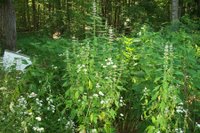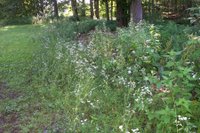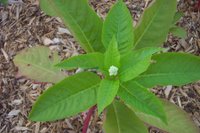 Most gardeners spend hours and hours pulling weeds. I’ve pulled quite a few. But what exactly is a weed? The dictionary definition is “A plant considered undesirable, unattractive, or troublesome, especially one growing where it is not wanted, as in a garden.”
Most gardeners spend hours and hours pulling weeds. I’ve pulled quite a few. But what exactly is a weed? The dictionary definition is “A plant considered undesirable, unattractive, or troublesome, especially one growing where it is not wanted, as in a garden.” We have jewel weed growing in the woods out to the lawn on one side of the yard. It is beautiful, fills in nicely and hides the trash left by the previous owners. I am encouraging it to fill in on the other side of the yard. We have tons of weeds I’d like to get rid of, poison ivy being at the top of the list, followed closely by locust tree seedlings.
We have jewel weed growing in the woods out to the lawn on one side of the yard. It is beautiful, fills in nicely and hides the trash left by the previous owners. I am encouraging it to fill in on the other side of the yard. We have tons of weeds I’d like to get rid of, poison ivy being at the top of the list, followed closely by locust tree seedlings.When I first decided on a butterfly garden I was attracted by the idea that several of the recommended plants had “weed” in their name and therefore should be easy to grow. I have planted butterfly weed and tropical milkweed.
When we first moved here, Bean let me dig some black-eyed susans and blanket flower from her garden. Last summer, to my delight, they both came back. I watered and fussed over them and the black-eyed susans finally rewarded me with tons of blooms. The blanket flower just got bigger and bigger and kept sending up funny looking stalks that never flowered. I now realize that I spent the summer nurturing a narrow leaf plantain and it was a very pretty, very large plantain. So large that I didn’t recognize it as being the same as the weeds in the lawn a mere two feet away! It is no longer in the flower bed but I laugh at myself when I see one of the dozens growing in the yard. It turns out that they are a butterfly host plant so I had started my garden without realizing it and they are welcome to remain in the yard.
 The fleabane growing at the edge of the woods is pretty. The motherwort I haven’t made up my mind about. The wild blackberries can stay in the areas that are wild but I have dozens to get rid of.
The fleabane growing at the edge of the woods is pretty. The motherwort I haven’t made up my mind about. The wild blackberries can stay in the areas that are wild but I have dozens to get rid of. In the area where the old willow was we had a huge weed patch. Before killing everything there to start a new bed I spotted a pretty little vine with heart shaped leaves and tiny white flowers. Needing something to cover the other willow stump I transplanted it. I have just learned that it is wild buckwheat, considered a weed. It will stay as I think it is pretty, certainly prettier than the stump I need covered.
In the area where the old willow was we had a huge weed patch. Before killing everything there to start a new bed I spotted a pretty little vine with heart shaped leaves and tiny white flowers. Needing something to cover the other willow stump I transplanted it. I have just learned that it is wild buckwheat, considered a weed. It will stay as I think it is pretty, certainly prettier than the stump I need covered. Also in the weed patch was some common milkweed or at least that’s what I thought the tiny seedlings looked like. I transplanted a dozen of them to the garden and nine survived and started to take off.
Also in the weed patch was some common milkweed or at least that’s what I thought the tiny seedlings looked like. I transplanted a dozen of them to the garden and nine survived and started to take off.While looking at various milkweed plants online I realized that it wasn’t milkweed as the leaves were alternate rather than opposite.
So I spent a good deal of time trying to find out what it was hoping that it would turn out to be another weed appropriate for a butterfly garden. This turned out to be a very frustrating task. I browsed and searched several university sites, I googled and then I discovered the Ontario Weeds site. I now know that I transplanted pokeweed! We have quite a bit of it growing around the edge of our property. John spent a long time trying to get rid of a pokeweed patch at Mom’s. At one point he thought the shovel might break, the tap root on the largest plant was huge. So why didn’t I recognize this weed? The ones at the edge of the property are ten feet tall and I just never pictured these nice little seedlings turning into such giants! I pulled them all out tonight and now have a large bare spot in the garden. I won’t be moving anymore plants until I know what they are!
If I like a “weed” I will continue to plant, encourage and coddle because by definition they aren’t really weeds at all.










No comments:
Post a Comment